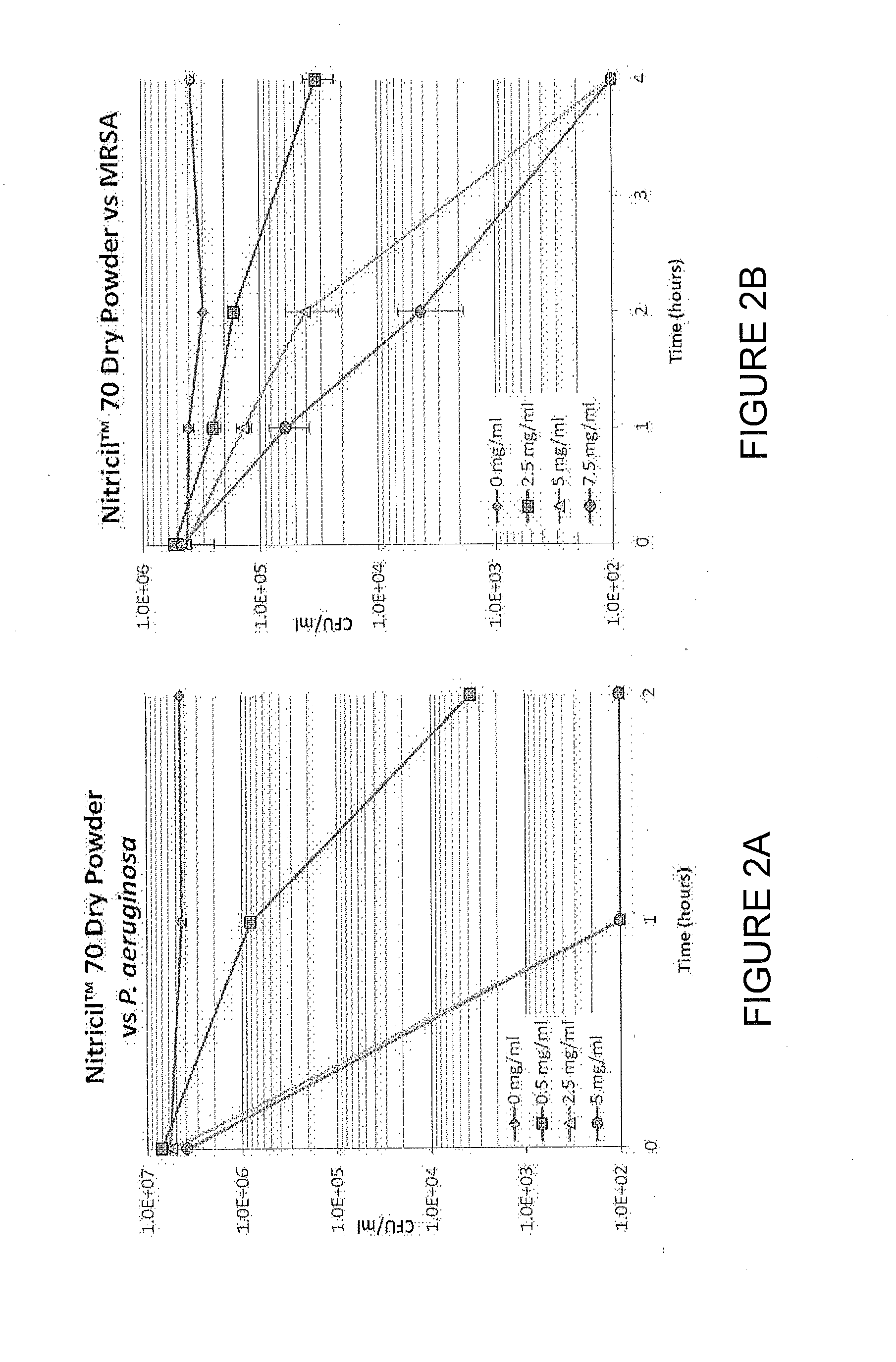Topical Gels and Methods of Using the Same
a gel and topical technology, applied in the field of topical gels, can solve the problems of inability to effectively treat the symptoms of a person or animal
- Summary
- Abstract
- Description
- Claims
- Application Information
AI Technical Summary
Benefits of technology
Problems solved by technology
Method used
Image
Examples
example 1
Synthesis of NO-Releasing Macromolecules
[0154]FIG. 1 illustrates the covalent storage of nitric oxide on the aminosilane N-methylaminopropyltrimethoxysilane as a diazeniumdiolate NO donor, followed by co-condensation with a backbone alkoxysilane, tetraethoxysilane, to form Nitricil™ composition 70. Such a NO-releasing macromolecule may be incorporated into medicaments according to some embodiments of the invention.
example 2
Efficacy of Nitricil™-70 Against Representative Gram-Positive and Gram-Negative Bacteria
[0155]The antimicrobial efficacy of Nitricil™-70 Dry Powder was assessed against representative multi-drug resistant Gram-positive (HA-MRSA, ATCC 33591, SCCmec Type III) and Gram-negative (P. aeruginosa, ATCC 15442) organisms using the ASTM E 2315 Test Method. Various concentrations of NJ070 particles were incubated, in duplicate, with P. aeruginosa (See FIG. 2A) or HA-MRSA (See FIG. 2B) at 37° C. in a 1:1000 dilution of Trypticase Soy Broth. At the indicated time points, an aliquot from each culture was serially diluted and plated to quantitate the viable colony forming units (CFU / ml) remaining.
[0156]Solid Nitricil™ 70 kills both P. aeruginosa and MRSA in a dose- and time-dependent manner, with 99.9 percent killing of P. aeruginosa achieved at earlier time points and lower concentrations than are required for HA-MRSA. These data suggest that Nitricil™ is active against both Gram-positive and Gra...
example 3
Efficacy of a Nitricil™ 70 Silicone-Based Gel in Full Thickness Excisional Wounds in a an Infected Rat Animal Model
[0157]A hydrophobic, non-aqueous NO-releasing gel was formulated using 75 percent Dimethicone / Vinyl Dimethicone Crosspolymer and ˜25 percent cyclomethicone co-solvent as a viscosity modifier. Nitricil™-70 at a weight of 24 mg (0.1% w / w final gel loading) or 240 mg (1.0% w / w final gel loading) was dispersed in 6 ml of the cyclomethicone and sonicated to provide a homogenous particle suspension based on the likeness of the silicone solvent and exterior of the co-condensed siloxane particles. The concentrations of the components are listed below in TABLE 1. The Nitricil™ suspension was then combined with dimethicone gel in a 1:3 ratio to provide the finished compositions for animal testing. Blank vehicle contained only dimethicone and cyclomethicone co-solvent absent of any NO-releasing macromolecules.
TABLE 1Nitricil ™ 70Dimethicone Cross Polymer Cyclomethicone0.1%75%24.9%...
PUM
| Property | Measurement | Unit |
|---|---|---|
| octanol/water partition coefficient | aaaaa | aaaaa |
| hydrodynamic radius | aaaaa | aaaaa |
| hydrodynamic radius | aaaaa | aaaaa |
Abstract
Description
Claims
Application Information
 Login to View More
Login to View More - R&D
- Intellectual Property
- Life Sciences
- Materials
- Tech Scout
- Unparalleled Data Quality
- Higher Quality Content
- 60% Fewer Hallucinations
Browse by: Latest US Patents, China's latest patents, Technical Efficacy Thesaurus, Application Domain, Technology Topic, Popular Technical Reports.
© 2025 PatSnap. All rights reserved.Legal|Privacy policy|Modern Slavery Act Transparency Statement|Sitemap|About US| Contact US: help@patsnap.com



